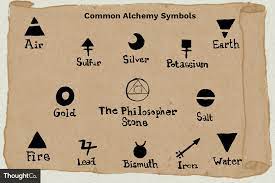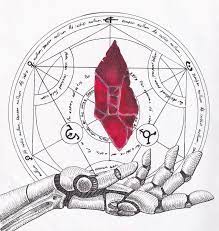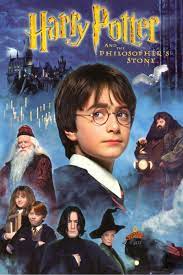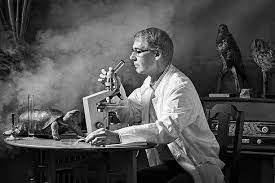For my item for Assignment 4, I chose the philosopher’s stone to focus on. To fully describe what a philosopher’s stone is, I first have to explain what alchemy is. According to the Encyclopedia Britannica, alchemy is “…a form of speculative thought that, among other aims, tries to transform base metals such as lead and copper into silver or gold and to discover a cure for disease and a way of extending life”. Alchemists did this by “…heating and refining the metal in a variety of chemical processes” (Encyclopedia Britannica). Alchemy is also referred to as “a seemingly magical process of transformation, creation, or combination” (Oxford Languages).

The philosopher’s stone is a substance that was often used by alchemists to “..transform base metals into precious ones, especially gold, and silver”. It is often portrayed as a red, jagged, translucent stone and has shown its face in various forms of media in pop culture.

For example, Harry Potter, Fullmetal Alchemist, The Flash, and Honey I Shrunk the Kids, all pretty well-known movies and TV shows, have all featured the philosopher’s stone at one point or another. Along with its ability to transform metals, cure disease, and extend life, this stone has also been known to symbolize the creation of life and ascension into Godhood (tvtropes.org). Alchemists also believed that an “…elixir of life could be derived from it” and many times these phrases are used interchangeably. An elixir of life oftentimes alludes to a liquid that can grant someone eternal life when paired with the philosopher’s stone (Encyclopedia Britannica).

The idea of this stone came about soon after alchemy first started being practiced. This pseudoscience originated in Egypt and remained a prominent feature of society in reference to early endeavors in chemistry. These concepts and practices not only remained relevant for centuries, but spread in influence all throughout Arabia, Greece, Rome, and eventually Western and central Europe, where the story of Frankenstein takes place. (Www.rsc.org).

In the early 1800s, Mary Shelley wrote the novel Frankenstein which we just recently completed in class. The main character of the book, Victor Frankenstein, is a scientist that has an obsessive fascination with the work of, at that point outdated, alchemists. By this time society had transitioned from the practice of alchemy to the practice of something more reminiscent of modern-day chemistry, but Victor was nonetheless fixated on the concepts related to alchemy such as everlasting life. We see the catalyst for this fascination on pages seventy-five and seventy-six of the novel. Victor quotes his natural philosophy professor at the University of Ingolstadt who explained how the ancient teachers of this science “…promised impossibilities, and performed nothing”. He then goes on to compare them to the “…modern master…” who “promises very little”. He talks about how they “…know that metals cannot be transmuted, and that the elixir of life is a chimera”. But they nonetheless have “…performed miracles…” and “…have acquired new and almost unlimited powers…” (Shelley, 75-76). This was an invaluable moment in Victor’s life in that it unleashed this unwavering determination within him. “Thus ended a day memorable to me; it decided my future destiny” (Shelley, 77). The study and implication of these concepts, such as the elixir of life, became Victor’s call to action in reference to him creating his creature.

Work Cited
The Editors of Encyclopedia Britannica.
“Philosopher’s Stone | Alchemy.” Encyclopedia Britannica, 2 May 2018, www.britannica.com/topic/philosophers-stone.
Multhauf, Robert P, and Robert Andrew Gilbert.
“Alchemy | Definition, History, & Facts.” Encyclopedia Britannica, 6 Mar. 2019, www.britannica.com/topic/alchemy.
Oxford Languages.
“Oxford Languages.” Oxford Languages, Oxford University Press, 2023, languages.oup.com/google-dictionary-en/.
“What Is Alchemy?”
Www.rsc.org, www.rsc.org/periodic-table/alchemy/what-is-alchemy#:~:text=The%20art%20of%20 alchemy%20was.
Shelley, Mary. Frankenstein.
1818. Beverly, Ma Rockport Publishers, 1 Jan. 1818.
“Philosopher’s Stone.”TV Tropes, tvtropes.org/pmwiki/pmwiki.php/Main/PhilosophersStone#:~:text=Examples%20of%20the%20 Philosopher%27s%20 Stone%20in%20 media%3A%20 open%2 Close. Accessed 10 Apr. 2023.
You must be logged in to post a comment.